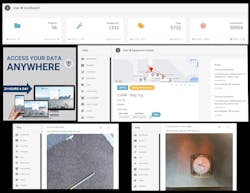How Electronic Inspections Promote Accountability and Improve Uptime
Before reading this article on electronic vehicle inspections and maintenance best practices, we encourage you to participate in our GSE Maintenance Research survey.
The survey only takes a few minutes, and the findings will be shared in a special report from Ground Support Worldwide.
And if you haven't already, be sure to download the eGSE Report.
Traditional paper checklists have been used by GSE maintenance teams for decades, but these programs can be flawed.
Chris Schaeffer, an industry veteran who has decades of fleet management experience including GSE, says these important documents are often not viewed as important to-do lists. But rather they are treated as another mundane task preventing ground personnel from completing their work.
“The data gotten from these are often unreliable,” Schaeffer says.
Additionally, paper checklists create storage issues.
“Where do we store them? For how long? Can we email them every day to the fleet manager?” Schaeffer points out, adding the information on the checklists can also be difficult to read. “And if the information needs to be retrieved in the event of an incident, it’s a project just to find the checklist from a specific date.”
Electronic inspections, on the other hand, are more reliable. Schaeffer says a fleet manager can start the morning in his or her office and easily see what inspections have been done that day.
To help reduce equipment damage, National Safety Solutions, headquartered in Kamloops, British Columbia, developed its Start Right inspection solution for GSE in 2015. According to company president Grant Toutant, the system was designed to combat a lack of due diligence from employees when performing inspections prior to moving and operating GSE.
“I owned a construction company and signed the checks for tens of thousands of dollars each year to fix or replace damaged assets from lack of inspections,” Toutant says, noting he quickly recognized the system’s application in ground handling. “It has many uses in all industries whenever verifiable accountability is required.”
By selecting a piece of equipment in an electronic inspection program, a fleet manager can see who performed a check, where and when it was done, as well as how long the inspection took to perform.
Specific requirements can be mandated, such as requiring a picture of the engine oil dipstick and the fuel gauge to be taken and uploaded to the system.
“I can see what was done, and more importantly what wasn’t done. If a prescribed inspection doesn’t happen, I can reach out to the station and see what's up. Often, it’s a machine that’s out of service for a failure and they forgot to report it as such, and I can catch that same day to manage that repair,” Schaeffer says, adding accuracy, speed and the recoverability of the data are critical features in an electronic inspection system. “It’s like going from a telegraph to a smart phone. The difference is that great.”
National Safety Solutions officials note its system is customizable based on a ground service provider’s need. For example, one variation allows users to ensure proper weight and balance by scanning the system's tag and taking photos to ensure the cargo bin has been completely loaded or unloaded into the correct bin.
“The airline could check their dashboard and see for themselves, for any aircraft from anywhere in the world, prior to the aircraft departing instead of finding out after the plane lands,” says Mike Batchelor, vice president of business development at National Safety Solutions.
Officials at National Safety Solutions add that the system can be used on catering trucks or carts, allowing the airline to know who and when the cart was secured, loaded or unloaded from an aircraft or catering truck. Pre-trip inspections for deicing trucks is also common with this system.
“Ensuring those vehicles are maintained and inspected properly during harsh winter months is priceless when it comes to getting aircraft out safely and on time,” Batchelor says. “All the different models and variations use the same tag and badge.”
“Countless updates and new modules have been added since the beginning,” Toutant adds. “We pride ourselves in being leaders in the tech industry, and we add new software at least every quarter and many times in between.”
Schaeffer notes the greatest advantage of an electronic inspection program is the ability to prove an inspection was completed.
“The ability to manage accountability for the inspection process makes the machines as safe and reliable as possible,” Schaeffer says, adding GSE fleet managers can benefit from accurate and recoverable data immediately available after an inspection. “Clean and unaltered data provides verifiable accountability in real time.”
With that real-time data, officials at National Safety Solutions say users can measure successes and identify shortfalls, which allow for the implementation of new procedures and streamlined protocols.
“Overall, there is a shift of confidence that things are being checked properly,” Schaeffer adds.
What to Consider in a GSE Checklist
The specifics of a GSE inspection program are dependent on the frequency of inspection and whether an asset is motorized.
“On a daily inspection, I look to have something that confirms the safety of the operator and the machine,” explains Schaeffer.
As a rule of thumb, Schaeffer recommends checking engine oil daily as well as confirming that seat belts, brakes and lights are all working properly. On a weekly basis, Schaeffer recommends checking other fluids and taking a deeper look at equipment.
Schaeffer notes fleet managers must be flexible to the needs of the specific location. For example, non-powered equipment may only need to be checked monthly for wear and tear, whereas certain motorized equipment may need more frequent inspections.
“No inspection program will prevent all failures, but it will reduce them,” Schaeffer says. “There is, however, no better return on investment (ROI) than a crisp inspection process. Making sure an engine has oil in it daily will significantly reduce catastrophic engine failure, for example. Uninspected equipment is almost certain to fail.”
Inspected failures are rarer. For example, Schaeffer says a leaking gasket caught early can be a straight-forward, inexpensive repair to complete. Catching the issue early can prevent oil from pooling and ultimately dripping on the exhaust, which can result in a fire.
The key to an effective GSE inspection program is ensuring machine reliability and operator safety. What’s more, a robust inspection program makes getting a warranty much easier.
GSE inspections vary based on each type of equipment.
“A K-loader and a belt loader will have different checks. Each inspection is going to be machine specific and time specific. An annual inspection for example will involve much more than a daily inspection,” Schaeffer points out.
Schaeffer says a piece of equipment should be inspected once every 24 hours, but he has made arguments in some circumstances for GSE to be inspected every eight hours.
More on GSE Maintenance
AviationPros Source eBook: GSE Maintenance
How to Determine the Best Source for GSE Maintenance
Preventative Maintenance for GPU Cables
Proper Methods for PCA Maintenance
Self-Performance Versus Outsourced GSE Maintenance
How Electronic Inspections Promote Accountability and Improve Uptime
A Guide to GSE Maintenance
Five Maintenance Tips To Keep GSE Running In Winter
About the Author
Josh Smith
Editor
Josh Smith served as editor of Ground Support Worldwide as editor from 2016 through 2024. He oversaw production of the print magazine, created GSW's newsletters on a daily basis, and updated the latest news on AviationPros.com.

